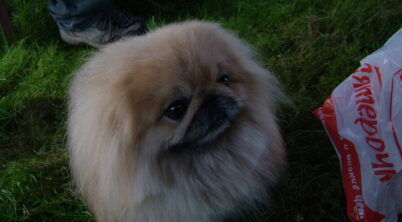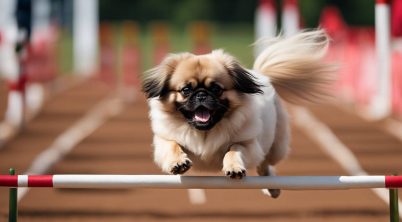The Pekingese is an ancient toy breed, treasured for centuries by Chinese royalty as a lap dog and companion. Characterized by their lion-like mane and unique rolling gait, these dogs present a combination of boldness and self-esteem, wrapped in a package of undeniable charm. Their long, luxurious coats require regular grooming, and their distinctive physical structure—with heavy forequarters and lighter hindquarters—gives them a pear-shaped appearance. For those considering adding a Pekingese to their family, adoption is a heartwarming and responsible way to find a new furry friend.
As a breed, Pekingese are known for their affectionate and devoted nature. They often form incredibly strong bonds with their owners and can be quite protective. When adopting a Pekingese, it is important to understand that while they are small in size, they come with a big personality and a set of needs that should be met to ensure their well-being. They can be sensitive about their food, so new owners should pay attention to their dietary requirements. Adopting a Pekingese means providing them with not just love and attention but also appropriate care and stimulation.
Adoption provides a lifeline to Pekingese dogs that have been relinquished for various reasons. Numerous rescue organizations and networks are dedicated to the rehoming of Pekingese dogs. They operate across various states, often covering veterinary and rescue costs through donations while ensuring that these dogs find suitable homes. Those interested in adoption can browse through available dogs, filter by location, age, and gender, and learn about each dog’s history and characteristics. Adoption policies vary across organizations, so potential adopters are encouraged to consult with these groups to understand the specific details involved in welcoming a Pekingese into their home.
Table of Contents
Understanding the Pekingese Breed
The Pekingese is an ancient breed hailing from China, with a history deeply entrenched in Chinese origins. They were highly regarded by Chinese emperors and were once found in royal palaces. This breed holds significance in the fabric of Chinese culture and was not widely known outside until the 19th century when British troops invaded the Chinese Imperial Palace during the Second Opium War. The Pekingese was brought to England as a spoil of war, with one being gifted to Queen Victoria, which increased the breed’s popularity.
Physical Characteristics:
- Size: Small
- Body: Compact, heavier in the front
- Coat: Thick with abundant mane, akin to a lion’s
- Gait: Unhurried, dignified, with a slight roll
Temperament:
The Pekingese embodies a bold spirit and courage that belies its small stature. It exhibits a dignified demeanour and an independent nature. Known for being extremely devoted and affectionate with their families, they can also be reserved around strangers.
Behavioral Traits:
- Devotion: Form strong bonds with owners
- Independence: May display aloofness
- Courage: Surprisingly brave for their size
In terms of care, potential adopters should be aware of the breed’s grooming needs due to their thick coat. Regular brushing is essential to prevent matting, and they may also require professional grooming services.
In summary, the Pekingese is suitable for those who appreciate a dog with a rich historical background, loyal companionship, and a manageable size. They thrive in a loving environment where their majestic yet affectionate nature is cherished.
Preparing for Adoption
When considering the adoption of a Pekingese dog, potential adopters should be aware of the specific requirements and steps involved in the process. Careful preparation ensures a smooth transition for both the dog and its new family.
Adoption Considerations
Age and Exercise: Pekingese dogs are available for adoption at various ages, and their exercise needs may differ accordingly. Older dogs may require less exercise compared to younger, more energetic ones. Prospective adopters living in an apartment should ensure their lifestyle can accommodate the exercise needs of a Pekingese.
Living with Children: Families with children should verify policies as some organizations do not adopt to homes with young children. This is due to the delicate nature of Pekingese canines which may not be suitable for the often unpredictable environment of a household with small kids.
Home Environment: A comfortable and safe home environment is crucial. Adopters should ensure their living situation is suitable for a Pekingese, taking into account the dog’s long coat and need for a cool, temperate space to avoid overheating.
Selection Process
Adoption Application: An adoption application is typically required to begin the adoption process. This document gathers information about the potential adopter’s living situation, experience with pets, and expectations of pet ownership.
- Personal references, a veterinary reference, and a home visit may be part of the application process.
Choosing the Right Pekingese: Selection should be based on compatibility with the adopter’s lifestyle. Some factors to consider include:
- Size: Pekingese are a small breed, suitable for those with limited space.
- Adult or Puppy: Adult dogs may be a better option for those looking for a less demanding pet in terms of training and upbringing.
- Gender: Decision on whether a male or female Pekingese suits the potential owner’s preference may also play a role.
Potential adopters should be patient and thorough during the selection process to ensure the best match between the Pekingese and their new family.
The Adoption Process
Adopting a Pekingese involves a series of steps including finding adoptable dogs, completing an application, and possibly interacting with rescue organizations across the USA. Prospective adopters should be prepared to engage with various organizations and adhere to their specific processes.
Finding Pekingese to Adopt
Prospective owners can find Pekingese for adoption through several channels. Rescue groups specializing in Pekingese can be found across many states, and these organizations often post available dogs on their websites or social media pages. Shelters, both local and nationwide, frequently have Pekingese dogs, or Pekingese mixes, looking for homes; details for these adoptable pets can also be viewed online.
- Petfinder, a widely recognized platform, lists Pekingese available for adoption from various rescues and shelters. It is a resourceful site that allows the user to filter searches by location, age, and other traits.
- Local adoption events and adoption fairs are places where one might meet Pekingese in need of a home.
Once a potential adopter finds a Pekingese they are interested in, they often can initiate the process by filling out an application form, which is usually available on the organization’s website. The application is an important part of the process where applicants provide personal details, experience with pets, and demonstrate they can provide a suitable home. Email communication is commonly used throughout the adoption process for inquiries and updates.
Post-Adoption Care
After adopting a Pekingese, the new owner’s focus should be on establishing a routine that fosters health, hygiene, and positive behavior in their new companion.
Health and Grooming
Pekingese dogs require regular grooming due to their long hair. Owners should brush their Pekingese multiple times a week to prevent matting and manage shedding. Additionally, eye cleaning is essential to prevent infections. Health check-ups should be scheduled regularly with a veterinarian to ensure vaccinations are up to date and to assess for common breed-related issues. It’s advisable to discuss the benefits of getting the Pekingese spayed or neutered with a vet to prevent unwanted litters and reduce health risks.
Nutrition plays a crucial role in the health of a Pekingese; they should be fed high-quality food tailored to their size, age, and exercise level. Portion control is important to avoid obesity, which can exacerbate health problems like respiratory issues.
| Grooming Task | Frequency |
|---|---|
| Brushing | Multiple times a week |
| Eye Cleaning | Daily |
| Professional Grooming | Every 4-6 weeks |
| Dental Care | Daily to weekly |
Training and Socialization
The Pekingese is known for its bold yet affectionate temperament, and while they can make excellent companions, they might exhibit stubborn traits. Consistent and patient training is essential to foster obedience. Positive reinforcement techniques work best.
Socialization should begin early, as Pekingese can be reserved around strangers. Exposing them to different people, pets, and environments will help them develop into well-adjusted adults. Avoiding overexertion is important due to their small stature; short, frequent walks and play sessions are ideal to meet their exercise needs.
| Training Focus | Tips |
|---|---|
| Obedience | Use positive reinforcement; stay consistent and patient |
| House Training | Establish a routine; use a designated area for bathroom breaks |
| Socialization | Introduce to various stimuli early; manage interactions carefully |
Adhering to these post-adoption practices will help ensure that a Pekingese thrives in its new home.
Supporting Pekingese Rescues
Pekingese rescues are dedicated non-profit organizations that focus on the well-being and rehoming of Pekingese dogs. Adopting a Pekingese from a rescue is not only a compassionate choice but also an economical one, with adoption fees averaging around $300. These fees are generally used to cover pre-adoption care costs, ensuring that the dogs are healthy and ready for their new homes.
Donations play a crucial role in sustaining rescue operations. Monetary gifts are typically directed towards veterinary costs, which include vaccinations, spay/neuter procedures, and any other necessary medical treatments. Beyond cash contributions, rescues also welcome donations in the form of food, bedding, and volunteer hours.
When considering homes for Pekingese, rescues are thorough in their evaluation process. They prioritize the compatibility of each dog with potential adopters, sometimes taking into account the presence of children and other pets. Furthermore, most rescues have a policy in place for the return of Pekingese to their care in any unforeseen circumstances where an adopter is unable to continue caring for their pet.
While it is a somber aspect to consider, the reality of death touches the lives of all pets, including those in rescues. Many rescues offer end-of-life care, ensuring that Pekingese receive compassion and dignity in their final days.
The support provided to Pekingese by rescues is invaluable. Prospective adopters are encouraged to reach out to their local Pekingese rescues to learn how they can help, whether through adoption, donations, or other means of support.








